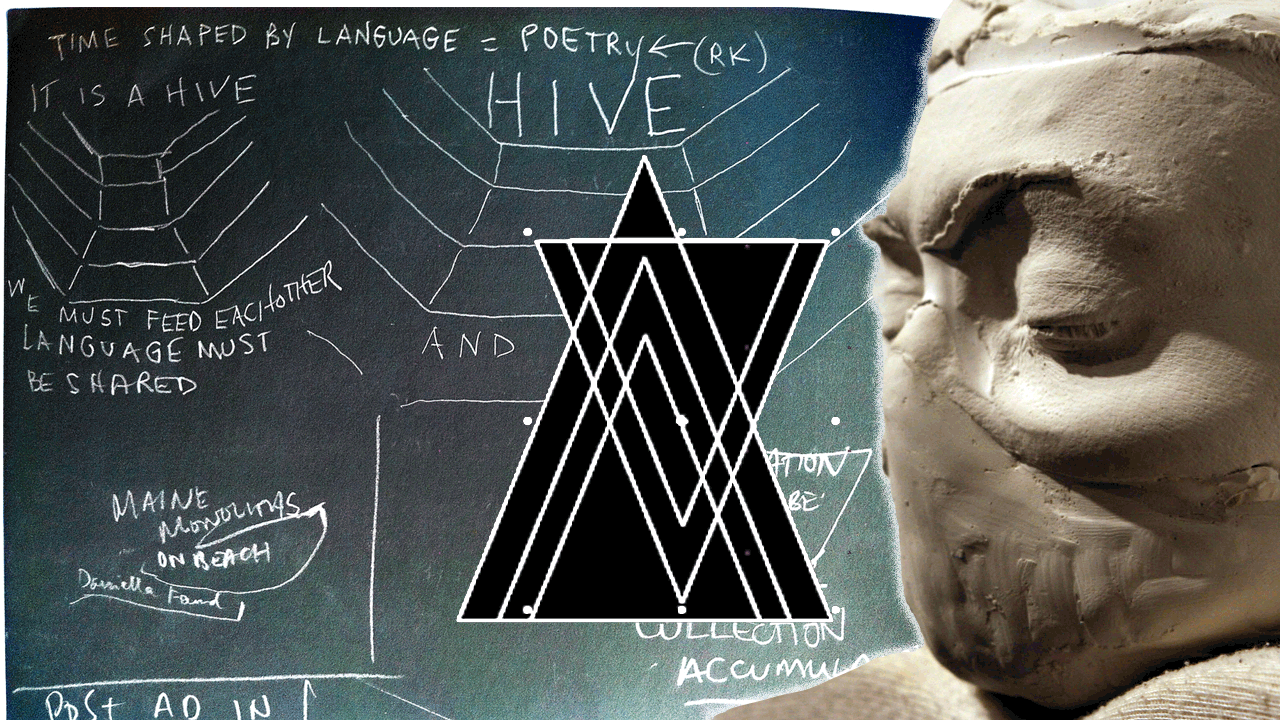ANIMAL’s feature Artist’s Notebook asks artists to show us their original “idea sketch” next to a finished piece. This week, Hudson, NY-based artist Parker Shipp shares a vast collection of notes about her sculpture HUSK, inspired by natural disasters, ubi sunt, Japanese Gutai and the Neolithic sculptures of Nevalı Çori and Göbekli Tepe. HUSK is currently on view at the Bruce High Quality Foundation’s last Brucennial.
Life and work is a collection. A collection of story, image, feeling, emotion and experience. Collections become memories, signifiers. And that forms the person. The person then decides how much of their collection they will divulge. What they can divulge.

My process usually begins with a collection, an accumulation of 3-dimensional objects, photographs, source images and video, letters, sounds. Assembled and arranged. The act of collecting is very important to the art. Each part of the collection a discovery. A dig. Salvaged with intent. The collection is then mixed down into symbols.

PROCESS NOTES (2012): “I became very interested in ancient civilizations and settlements, buried, forgotten and the recent discovery of places like Çatalhöyük in Turkey and the Neolithic temples and sculptures of Nevalı Çori and Göbekli Tepe. In my research I became especially interested in the digs revealing the evidence—civilizations deposited, layers of life over more layers of life eventually becoming an earth monument. The architecture and design of domestic spaces, areas of worship, tools of civilization, death rituals and traditions of afterlife especially influenced me.”

A simplified, graphic mythology might emerge. Drawings and words coming up first. This project had a distinct connection to nature. And time. Which I have come to see as the same thing.

PROCESS NOTES (2012): “Discovering remnants of human activity obsessed me and, like an archaeologist, I began arranging and categorizing the fragments in my mind and sketchbook, piecing together a would-be narrative for what seemed to be my own myth. Then, I knew what I was meant to do. I was to make my own. My own dig. My own midden.”

It is exploding, unstable, steady and constant
our most reliable guide and merciless oppressor–Time
Together, within, we are anonymous servants
And in return, we are never alone.Time is the husk,
our gentle accomplice.

INSPIRATIONS/INFLUENCES:
Short novel Le Mont Analogue by French surrealist René Daumal
Body Configurations Performances by Valie Export
Japanese Gutai
The architecture of pyramids
Ubi sunt
mummification, burial traditions
Natural Disasters, Man v. Nature, Nature and time as ultimate oppressor



Reclaiming and refuse tactics used after Hurricane Katrina and Rita on the Gulf Coast. Stacks of organized and collated refuse lined the roads. Categorized for disposal. I grew up along the Gulf Coast.
Look, life is only comprehensible through a thousand local gods… spirits of certain trees, of certain curves of brick walls, of certain fish and chip shops if you like. And slate roofs, and frowns in people, and slouches… I’d say to them, “Worship all you can see, and more will appear… ― Peter Shaffer, Equus
With arms outstretched overhead, I do my best to contain it by collecting it. Experience and memory become signifiers. By hunting and gathering, piling things on, stacking things up, lining things up, I expose my obsessive process of processing. In this repetition there is both variance and bondage, there is call & response, there is dance, there is me. This act of reframing and rearranging time enables me to create a space where I belong, and in sharing this, there is affirmation. I am here.
In HUSK, I am bowing down, folded and flexed, to the absolutes and instabilities of nature, to the passage of time. HUSK is about faith—the living cannot know everything—and we are not easily contained.
HUSK is about patience, mortality and the subtle truths that surround the transience of this life. It is the husk that protects, and it is the husk that must be peeled away.
Making photos and videos first exposed my interest in the copy, the duplicate, facsimile and the way appropriation can hold time.

From there, I became interested in manufacturing, mold making and casting, which seemed to carry a different weight.

PROCESS NOTES (2012): In my mound are fragments of cast body parts from my own body—disembodied facial features, fists, elbows, feet, and shackled arms akimbo. Sprinkled in are disparate relics of refuse, cracked and cratered—uniformed by the white of their plaster. The more I work with this idea of a burial or effigy the more I turn to history and archaeology, ancient architecture and monument, tombs and temples, and objects and sites which behold the forces of mysterious power.

HUSK has been an ongoing, durational project that’s now spanned over two years and has materialized in the three installations.
I’ve poured what has become pounds and pounds of plaster and white concrete and have pulverized just as much to make rubble and dust.
Along the way, this totally physical process has become a performance. A jig. A release. The next iteration of this piece will be focused on the performance aspect involved in the installation of such a work, and it is my hope that it will culminate in its complete destruction.

Oh, gentle flood
come
rearrange the furniture
PARKER SHIP, HUSK (2012-…)

Previous Artist’s Notebook selects:
Artist’s Notebook: Eva Papamargariti
Artist’s Notebook: Brenna Murphy
Artist’s Notebook: Mike and Claire
Artist’s Notebook: Gordon Holden
Artist’s Notebook: Rafaël Rozendaal
Artist’s Notebook: Genevieve Belleveau
Artist’s Notebook: Georges Jacotey
Artist’s Notebook: Andrew Ohanesian
Artist’s Notebook: Saoirse Wall
Artist’s Notebook: Jesse Darling
Artist’s Notebook: Melissa F. Clarke
Artist’s Notebook: Don Hertzfeldt







